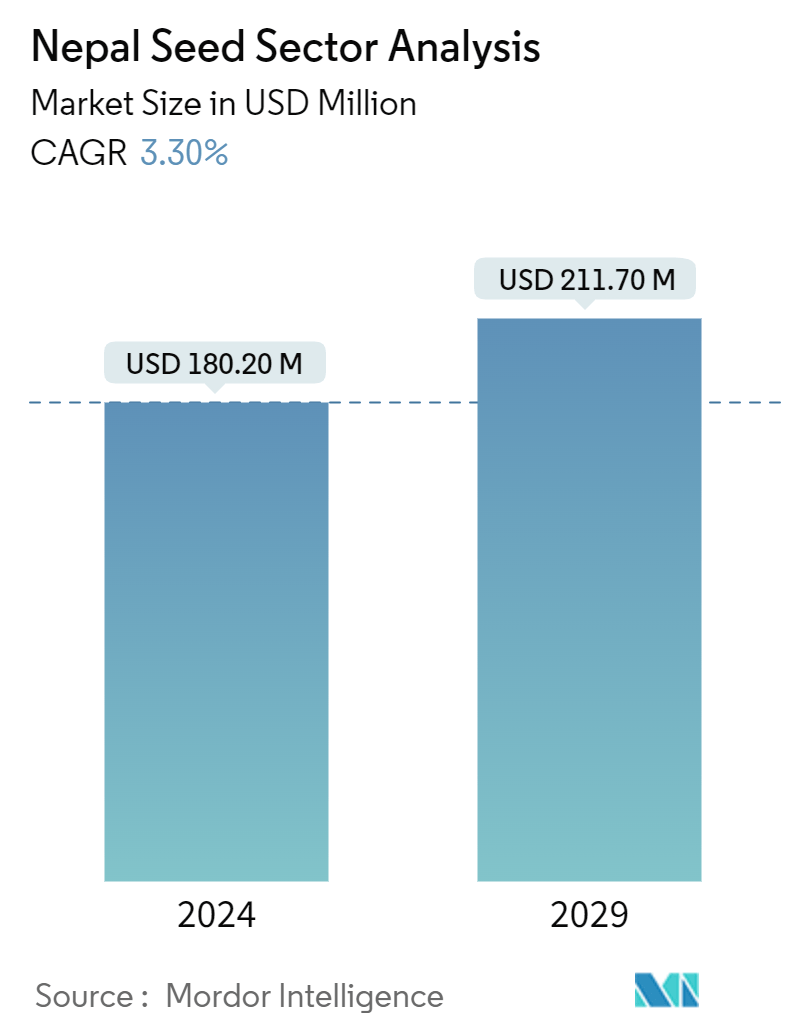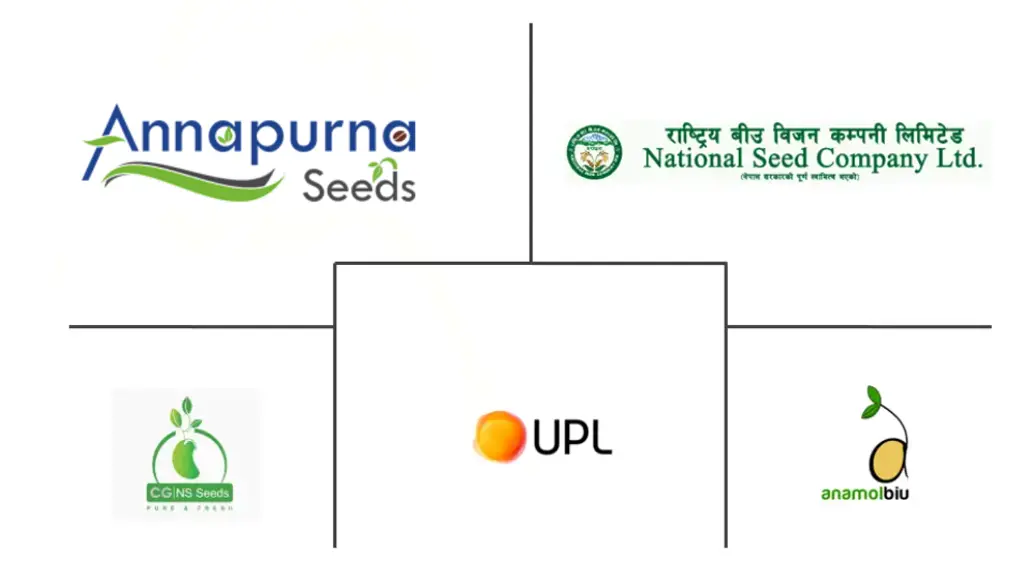Market Size of Nepal Seed Sector Analysis

| Study Period | 2019 - 2029 |
| Base Year For Estimation | 2023 |
| Market Size (2024) | USD 180.20 Million |
| Market Size (2029) | USD 211.70 Million |
| CAGR (2024 - 2029) | 3.30 % |
| Market Concentration | Medium |
Major Players
*Disclaimer: Major Players sorted in no particular order |
Nepal Seeds Market Analysis
The Nepal Seed Market size is estimated at USD 180.20 million in 2024, and is expected to reach USD 211.70 million by 2029, at a CAGR of 3.30% during the forecast period (2024-2029).
- Nepal's seed market plays a vital role in the country’s agricultural sector, which has been steadily evolving in recent years. With a growing population and increasing focus on food security, there is a stronger focus on enhancing seed quality and variety. Government initiatives aimed at improving seed production and distribution have been key drivers in the market’s development.
- In 2023, the government updated its agricultural subsidy scheme to a production-based system to promote the use of quality seeds. This policy aims to achieve self-sufficiency in seed supply, encouraging the private sector to invest in research to develop high-quality seeds. The government has allocated around USD 4.8 million (Rs 400 million) to support this initiative, providing a 50% subsidy on quality and high-yielding seeds purchased by farmers through local producers.
- Hybrid seeds have seen growing demand in Nepal due to their higher yield potential and resistance to pests and diseases. Government bodies like the Seed Quality Control Center ensure farmers have access to certified hybrid seeds. However, hybrid seed adoption is still in its early stages, for instance, in 2022, hybrid maize seeds only covered 10-15% of Nepal’s maize acreage, all of which relied on imports. This provides an opportunity for companies to increase their market share by offering quality and affordable seeds.
- The government collaborates with various stakeholders at national, provincial, and local levels to strengthen the country’s seed system. This includes disseminating technologies, building technical capacity, and reforming policies to maximize impact. For instance, the U.S. Agency for International Development (USAID) project targets seed testing and development at the federal level. These efforts are essential for creating a resilient and sustainable seed industry in Nepal.
Nepal Seeds Industry Segmentation
A seed is the ripened, fertilized ovule of a flowering plant containing an embryo capable of germination to produce a new plant. This report focuses on seeds for sowing at the farmer level, with market sizing conducted at this level. It segments the market based on crop type (Grains and Cereals, Pulses and Oilseeds, Cotton, Vegetables, and Other Crops), breeding technology (Hybrids and Open Pollinated Varieties & Hybrid Derivatives), and cultivation mechanism (Open Field and Protected Cultivation). The market volume is presented in metric tons, and the market value is expressed in USD.
| Crop Type | |
| Grains and Cereals | |
| Pulses and Oilseeds | |
| Cotton | |
| Vegetables | |
| Other Crops |
| Breeding Technology | |
| Hybrids | |
| Open Pollinated Varieties & Hybrid Derivatives |
| Cultivation Mechanism | |
| Open Field | |
| Protected Cultivation |
Nepal Seed Sector Analysis Size Summary
The Nepalese seed market is experiencing a notable transformation, driven by the increasing adoption of hybrid seeds to enhance food security. This shift is largely due to the pressures of a growing population, urbanization, and the reduction of arable land, which have necessitated a boost in agricultural productivity. Government policies supporting Intellectual Property Rights for domestic seed varieties and production are further propelling market growth. The market is characterized by a mix of public and private sector involvement, with public entities focusing on cereal crop seed multiplication and private companies playing a significant role in vegetable seed production. Key players in this sector include UPL Limited, National Seed Vision Company Limited, CGNS Seeds Pvt. Ltd, and Sarba Shrestha Seeds.
The demand for hybrid seeds is on the rise, as they offer higher production potential and quicker returns on investment compared to local varieties. This has led to a substantial increase in hybrid seed imports, highlighting the need for developing suitable hybrid and open-pollinated varieties to meet local farmers' preferences. To address this, the Nepal Ministry of Agriculture has implemented policies like the National Seed Vision and Seed Regulation, aiming to enhance the seed industry's dynamism, promote self-sufficiency, and increase the export of high-quality seeds. These initiatives are crucial for reducing dependency on imports and supporting the country's agricultural sector in meeting the challenges posed by demographic and economic changes.
Nepal Seed Sector Analysis Market Size - Table of Contents
-
1. MARKET DYNAMICS
-
1.1 Market Overview
-
1.2 Market Drivers
-
1.2.1 Growing Agricultural Sector
-
1.2.2 Increasing Awareness of Hybrid Seeds
-
1.2.3 Government Support and Policies
-
-
1.3 Market Restraints
-
1.3.1 Limited Access to Quality Seeds
-
1.3.2 Underdeveloped Infrastructure
-
-
1.4 Porter's Five Forces Analysis
-
1.4.1 Bargaining Power of Suppliers
-
1.4.2 Bargaining Power of Buyers
-
1.4.3 Threat of New Entrants
-
1.4.4 Threat of Substitute Products and Services
-
1.4.5 Intensity of Competitive Rivalry
-
-
-
2. MARKET SEGMENTATION
-
2.1 Crop Type
-
2.1.1 Grains and Cereals
-
2.1.2 Pulses and Oilseeds
-
2.1.3 Cotton
-
2.1.4 Vegetables
-
2.1.5 Other Crops
-
-
2.2 Breeding Technology
-
2.2.1 Hybrids
-
2.2.2 Open Pollinated Varieties & Hybrid Derivatives
-
-
2.3 Cultivation Mechanism
-
2.3.1 Open Field
-
2.3.2 Protected Cultivation
-
-
Nepal Seed Sector Analysis Market Size FAQs
How big is the Nepal Seed Market?
The Nepal Seed Market size is expected to reach USD 180.20 million in 2024 and grow at a CAGR of 3.30% to reach USD 211.70 million by 2029.
What is the current Nepal Seed Market size?
In 2024, the Nepal Seed Market size is expected to reach USD 180.20 million.

